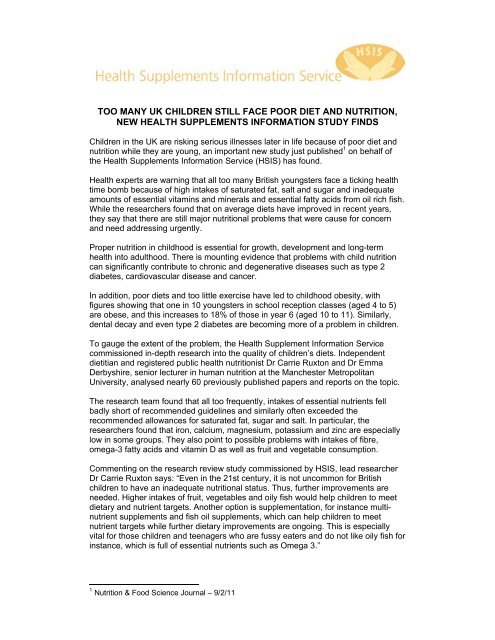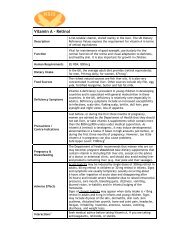too many uk children still face poor diet and nutrition, new health ...
too many uk children still face poor diet and nutrition, new health ...
too many uk children still face poor diet and nutrition, new health ...
You also want an ePaper? Increase the reach of your titles
YUMPU automatically turns print PDFs into web optimized ePapers that Google loves.
TOO MANY UK CHILDREN STILL FACE POOR DIET AND NUTRITION,<br />
NEW HEALTH SUPPLEMENTS INFORMATION STUDY FINDS<br />
Children in the UK are risking serious illnesses later in life because of <strong>poor</strong> <strong>diet</strong> <strong>and</strong><br />
<strong>nutrition</strong> while they are young, an important <strong>new</strong> study just published 1 on behalf of<br />
the Health Supplements Information Service (HSIS) has found.<br />
Health experts are warning that all <strong>too</strong> <strong>many</strong> British youngsters <strong>face</strong> a ticking <strong>health</strong><br />
time bomb because of high intakes of saturated fat, salt <strong>and</strong> sugar <strong>and</strong> inadequate<br />
amounts of essential vitamins <strong>and</strong> minerals <strong>and</strong> essential fatty acids from oil rich fish.<br />
While the researchers found that on average <strong>diet</strong>s have improved in recent years,<br />
they say that there are <strong>still</strong> major <strong>nutrition</strong>al problems that were cause for concern<br />
<strong>and</strong> need addressing urgently.<br />
Proper <strong>nutrition</strong> in childhood is essential for growth, development <strong>and</strong> long-term<br />
<strong>health</strong> into adulthood. There is mounting evidence that problems with child <strong>nutrition</strong><br />
can significantly contribute to chronic <strong>and</strong> degenerative diseases such as type 2<br />
diabetes, cardiovascular disease <strong>and</strong> cancer.<br />
In addition, <strong>poor</strong> <strong>diet</strong>s <strong>and</strong> <strong>too</strong> little exercise have led to childhood obesity, with<br />
figures showing that one in 10 youngsters in school reception classes (aged 4 to 5)<br />
are obese, <strong>and</strong> this increases to 18% of those in year 6 (aged 10 to 11). Similarly,<br />
dental decay <strong>and</strong> even type 2 diabetes are becoming more of a problem in <strong>children</strong>.<br />
To gauge the extent of the problem, the Health Supplement Information Service<br />
commissioned in-depth research into the quality of <strong>children</strong>’s <strong>diet</strong>s. Independent<br />
<strong>diet</strong>itian <strong>and</strong> registered public <strong>health</strong> <strong>nutrition</strong>ist Dr Carrie Ruxton <strong>and</strong> Dr Emma<br />
Derbyshire, senior lecturer in human <strong>nutrition</strong> at the Manchester Metropolitan<br />
University, analysed nearly 60 previously published papers <strong>and</strong> reports on the topic.<br />
The research team found that all <strong>too</strong> frequently, intakes of essential nutrients fell<br />
badly short of recommended guidelines <strong>and</strong> similarly often exceeded the<br />
recommended allowances for saturated fat, sugar <strong>and</strong> salt. In particular, the<br />
researchers found that iron, calcium, magnesium, potassium <strong>and</strong> zinc are especially<br />
low in some groups. They also point to possible problems with intakes of fibre,<br />
omega-3 fatty acids <strong>and</strong> vitamin D as well as fruit <strong>and</strong> vegetable consumption.<br />
Commenting on the research review study commissioned by HSIS, lead researcher<br />
Dr Carrie Ruxton says: “Even in the 21st century, it is not uncommon for British<br />
<strong>children</strong> to have an inadequate <strong>nutrition</strong>al status. Thus, further improvements are<br />
needed. Higher intakes of fruit, vegetables <strong>and</strong> oily fish would help <strong>children</strong> to meet<br />
<strong>diet</strong>ary <strong>and</strong> nutrient targets. Another option is supplementation, for instance multinutrient<br />
supplements <strong>and</strong> fish oil supplements, which can help <strong>children</strong> to meet<br />
nutrient targets while further <strong>diet</strong>ary improvements are ongoing. This is especially<br />
vital for those <strong>children</strong> <strong>and</strong> teenagers who are fussy eaters <strong>and</strong> do not like oily fish for<br />
instance, which is full of essential nutrients such as Omega 3.”<br />
1 Nutrition & Food Science Journal – 9/2/11
Low vitamin D levels in childhood can lead to a greater risk of low bone mass <strong>and</strong><br />
osteoporosis later in life. Inadequate intakes of certain nutrients such as iron, iodine,<br />
folate, zinc, vitamin B12 <strong>and</strong> long-chain omega-3 polyunsaturated fatty acids have<br />
also been linked with affecting <strong>children</strong>’s cognition <strong>and</strong> intellectual ability.<br />
Much of the published research <strong>and</strong> data focuses on analysis of the UK National Diet<br />
<strong>and</strong> Nutrition Survey (NDNS), a rolling cross-sectional survey of food consumption,<br />
nutrient intakes <strong>and</strong> <strong>nutrition</strong>al status of people aged 18 months <strong>and</strong> older in the UK.<br />
The first – <strong>and</strong> latest - report of the programme, funded by the Food St<strong>and</strong>ards<br />
Agency <strong>and</strong> the Department of Health, includes in-depth data on food consumption<br />
<strong>and</strong> nutrient intakes for <strong>children</strong> aged 1.5 to 18 years taken between 2008 <strong>and</strong> 2009.<br />
In the latest research for HSIS, the researchers highlight findings by the Scientific<br />
Advisory Committee on Nutrition - an advisory committee of independent experts that<br />
provides advice to the Food St<strong>and</strong>ards Agency <strong>and</strong> Department of Health. The<br />
SACN report found that while <strong>children</strong>’s <strong>diet</strong>s had improved over the last 15 years,<br />
with certain <strong>nutrition</strong>al areas were <strong>still</strong> significantly lacking.<br />
Supplementation levels<br />
The data shows that vitamin <strong>and</strong> mineral supplements appear to make a significant<br />
contribution to overall nutrient intakes in <strong>children</strong> aged 2-17 years. Supplement use<br />
appears to vary between ethnic groups, with Asian or Afro-Caribbean <strong>children</strong> being<br />
most likely to take supplements, particularly cod liver oil. However, the researchers<br />
found that <strong>children</strong> most in need of supplements are often less likely to take them.<br />
Among <strong>children</strong> aged 4-12 years, multivitamins were the most commonly-consumed<br />
supplement, although the researchers say that iron is also important as deficiency is<br />
common in UK <strong>children</strong>, especially in those who are vegetarian or have low meat<br />
intakes.<br />
- Ends -<br />
The Health Supplements Information Service (HSIS) (www.hsis.org.<strong>uk</strong>; Tel: 020 7052<br />
8955) is an independent information body, set up to provide balanced information on<br />
vitamins <strong>and</strong> minerals. It is supported by a restricted educational grant from the<br />
Proprietary Association of Great Britain (PAGB).<br />
Note to editors:<br />
Salt<br />
The largest contributors of sodium purchasers of salt are table salt (23%), processed<br />
meat (18%), bread <strong>and</strong> bakery products (13%), dairy products (12%). More than a<br />
third of sodium purchased (37%) was accounted for by bread, bacon, milk, cheese<br />
<strong>and</strong> sauces. (AJCN, December 2010).<br />
Fruit <strong>and</strong> vegetables<br />
The research for HSIS shows that average consumption of fruit <strong>and</strong> veg was 170-<br />
190g/day in younger <strong>children</strong>, increasing to an average of 200g/day in 15-18 year<br />
olds. While there is no child-specific target for grams of fruit <strong>and</strong> vegetables, the adult<br />
guideline is 400g/day or more - <strong>children</strong> aged over 11 would be expected to need<br />
close to this. In addition, 20% of 4 -18 year olds consumed no fruit at all (excluding<br />
fruit juice) while 4% ate no vegetables. Other research indicated that among 11-18
year olds, boys had on average 3.4 portions of fruit <strong>and</strong> veg a day, <strong>and</strong> girls had on<br />
average 2.8. However, only 22% of boys <strong>and</strong> 7% of girls met the five-a-day target.<br />
Oily fish / omega 3 essential fatty acids<br />
Average intakes of oily fish ranged between 5-10g/week <strong>and</strong> 5-7g/week for males<br />
<strong>and</strong> females aged 4-18 years respectively, the equivalent of less than 0.1 of a portion<br />
per week, which is far lower than the recommended two portions per week.<br />
Nutrients <strong>and</strong> minerals<br />
The research shows that in young females, only 58% currently meet the reference<br />
nutrient intake (RNI) for iron, <strong>and</strong> previous studies have found that young vegetarian<br />
girls consuming fibre-rich <strong>diet</strong>s are most at risk of iron deficiency. In addition,<br />
calcium, magnesium, zinc, potassium, iodine <strong>and</strong> folate deficiencies appear to be<br />
increasingly apparent, especially in <strong>children</strong> from low-income groups.<br />
Vitamin D<br />
There are increasing worries that <strong>many</strong> UK <strong>children</strong> are vitamin D deficient, <strong>and</strong> the<br />
research backs up this concern, particularly for <strong>children</strong> in low-income families. Data<br />
from this group shows that boys <strong>and</strong> girls consumed on average 2.2µg <strong>and</strong> 1.92µg<br />
vitamin D per day respectively - these intakes are less than half of the European<br />
Recommended Daily Allowance of 5µg. In one study of 12-15 year olds in Northern<br />
Irel<strong>and</strong> daily vitamin D intakes were just 1.7µg. Another study found that 36% of<br />
school-age <strong>children</strong> were defined as vitamin D deficient, rising to 46% during the<br />
winter because of limited sunshine. Vitamin D is essential required for normal bone<br />
growth <strong>and</strong> development during childhood <strong>and</strong> adolescence <strong>and</strong> the latest research<br />
has linked vitamin D deficiency with a host of serious <strong>health</strong> issues.




